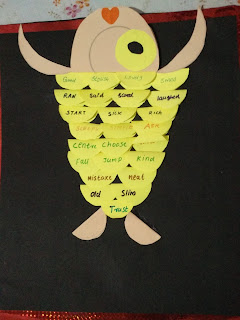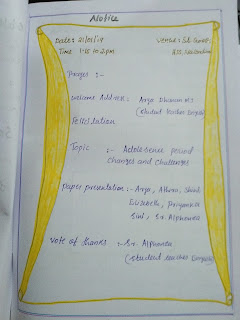BOOK REVIEW-TO SIR WITH LOVE
REVIEW
OF- TO SIR,WITH LOVE
Those
of you who are in your teens - how many of you desist to be told what
to do and how to do, what to study and when to study?
Teenagers
demand to be treated as adults but are seldom dealt that way. This
forces them to rebel, often voicing their opinions vehemently. At
home or at school, they face the same situation. But what if there
comes a teacher who rather than bombarding them with sermons and
bookish knowledge, enlightens them not only about their syllabus but
also life, and treats them with respect, with equality.
To
Sir, With Love is one such story. Written by E. R. Braithwaite, the
autobiographical novel is set in the East End of London, and portrays
the society and culture prevalent in the UK, post-World War II.
The
book takes us through the life of the author who despite having
excellent qualifications is denied job suited for his education
because of his black colour (racial discrimination existed deeply in
society in those times). He thus takes the teaching job at Greens
lade School, a secondary school in East End in London, as that's the
best job he could get at that time. But the school's culture presents
another shock to the prim teacher. Having worked in Royal Air Force,
Braithwaite finds it hard to be surrounded by undisciplined,
unmotivated and unclean students. He tries to teach them but becomes
a victim of their pranks, unruly attitude and rude remarks. But the
fighter in him refuses to hang up his boots. He decides to change his
teaching style. So instead of teaching them book lessons, he starts
giving them life lessons. The students, he tells them, would be
treated as adults by him and in return they need to bestow the same
kind of respect towards each other and their teachers. He gradually
begins preparing them for life post-school. And that's
when
things begin to shape up for the author, and his students start
responding positively to his efforts.
The
ups and downs in his life, his interactions with his class and their
transformation from rowdy teenagers to young responsible adults is
what keeps a reader glued to the book till the end. In between,
Braithwaite does talk about the racial discrimination meted out to
him due to his colour.
Published
first in 1959, the beauty of ‘To Sir, With Love’ lies in the
portrayal of relationship between a teacher and his students. It is
this journey of Braithwaite that makes this book timeless; and lives
with a reader long after the story ends. To Sir, With Love is a 1959
autobiographical novel by E. R. Braithwaite set in the East End of
London. The novel is based on true events concerned with Braithwaite
taking up a teaching post in a school there.
Most
of the pupils in his class are unmotivated to learn, and are only
semi-literate and semi-articulate. He persists despite their
unresponsiveness to his approach. Students attempt to discourage and
demoralise him by disruptive noises, constant use of the adjective
"bleeding" in the classroom and, finally, the burning of a
used sanitary towel in the fireplace. This last causes Braithwaite to
lose his temper and reprimand all the girls.
Braithwaite
decides to try a new approach, and sets some ground rules. The
students will be leaving school soon and will enter adult society, so
he will treat them as adults and allow them to decide what topics
they wish to study. In return, he demands their respect as their
teacher. This novel approach is initially rejected, but within a few
weeks the class is largely won over. He suggests out-of-school
activities including visits to museums, which the students have never
experienced before. A young teacher, Gillian Blanchard, volunteers to
assist him on these trips. Some of the girls start to speculate
whether
a personal relationship is budding between Braithwaite and Gillian.
The trip is a success and more are approved by the initially
sceptical headmaster.
The
teachers and the Student Council openly discuss all matters affecting
the school including curricula. The general feeling is that
Braithwaite's approach is working, although some teachers advocate a
tougher approach.
The
mother of one of the girls speaks privately to Braithwaite about the
girl's troubling attraction to nightlife, feeling that he has more
influence with her impressionable daughter.
Braithwaite
and Gillian fall deeply in love and discuss marriage. Her parents are
openly disapproving of a mixedrace marriage, but realise that the
couple are serious and intelligent and must be trusted to make the
right decision.
All
that To Sir, With Love really achieves is a sordid demonstration of
the author's vanity. Nor is his description of specifically racial
problems any more discerning. Mr. Braithwaite is shocked when refused
social status equal to a Briton with academic qualifications and
level of conduct similar to his own; and he constantly stresses the
ease with which he could assimilate into British society if only his
colour were disregarded [...] Prejudice against him is unfair, he
claims, because of his social accomplishment, not because of his
humanity; and he implies thereby that prejudice against black people
who lack similar cultural habits may be justified.
The
book’s title derives from the inscription on the end-of-school gift
that the students presented to Braithwaite at their graduation dance.
Reconstructed conversations constitute at least one-third of the
text; the balance of the book consists of narrative and interior
monologue. The first chapter opens with Braithwaite on his way to
interview for a teaching position at Greenslade Secondary School. He
took the post believing it to be merely a job, not a calling or a
labour of love. He was oriented to the new job by an experienced
teacher, who discussed his specific duties, and by the headmaster of
the school, who discussed its philosophy and students.
Chapters
4 and 5 flash back to the eighteen months of unsuccessful searching
for an engineering position that preceded Braithwaite’s arrival at
Greenslade. During that time, he had interviewed for numerous
positions, always being told, “I am sorry; we cannot use you,”
sometimes with the additional explanation that the company could not
employ a black man to supervise white people who had been with the
company for a number of years. In his six years of military service,
his skin colour had never been an issue; now it made him feel that,
although he was British, he was not a Briton. Whenever he applied for
technician’s jobs and lower positions than the engineering or
science work for which he was qualified, he was told that he was too
well dressed, well spoken, or well educated for the job.
A
chance encounter with a stranger, an older gentleman on a park bench,
saved Braithwaite from complete dejection and pointed him toward a
teaching career. The older man advised him to seek a teaching
position; skin colour would not matter, the stranger believed and
post-war London had a teacher shortage. That Braithwaite had a
lengthy conversation with the older stranger and took his advice
without ever learning the man’s name is one of the wealth of
interesting details of the book that the reader remembers.
Alex
Florian, the school’s headmaster, had a progressive,
student-centered philosophy of nonpunitive, warm, and informal
education. The approach baffled, puzzled, and nearly defeated
Braithwaite who, as a new teacher, had not yet determined his own
philosophy of education.
His
class consisted of forty-six teenagers who, at first, were hostile,
unruly, and very good at teacher baiting. They were as resistant to
academic learning as they were to learning courtesy. Although he felt
despondent and ineffectual, believing that things were not working
well and that he was not teaching the students enough, Braithwaite
kept trying. He gradually won the students’ respect by offering
respect—along with consistent discipline, effective instruction,
and genuine caring. By the end of the school year, Braithwaite was a
beloved, warmly accepted, and clearly very effective teacher who was
visible in the community and well-known to the students’ parents.
CONCLUTION
To
Sir, with Love has aged gracefully and deserves its continuing
readership among young adults. Although it was written for a general
adult audience, young readers will find the book’s treatment of
many topics to be engaging and instructive: human relations,
prejudice and discrimination, the problems of growing up and learning
how to find useful work and make a living, educational institutions,
economic inequities, and teacher-student relations. Although some
questions might be raised about Braithwaite’s accuracy in reporting
past events and reconstructing conversations, his writing skill
produces a unified, accessible work that clearly depicts post-war
London and some quite likable teachers and students.
Perhaps
more important, the book presents an engaging self-portrait of a
strong teacher, an educator who is of interest to young adults
because they can identify with his problems and successes, his early
insecurities and growing confidence in his teaching, and his initial
rebuffs and later total acceptance by the community. Braithwaite’s
intelligence, sensitivity, interpersonal skills, high expectations of
his students, and ability to motivate them are apparent throughout
the book.
The
racial prejudice that Braithwaite encountered in post-World War II
England played a major role in his decision to enter teaching.
Discrimination against him did not end, however, when he accepted the
teaching position. In the early months at Greenslade, for example, he
was refused a room that he wanted to rent when the woman who had
advertised the room saw his skin colour. The white, working-class
neighbourhood had abundant biases, which are dealt with openly and
honestly in the book.
Consequently,
it is ironic that, in the light of the strong theme of prejudice,
Braithwaite is guilty of stereotyping his young female characters,
just as prospective employers stereotyped him when they subjected him
to numerous rebuffs under the assumption that a black man could not
supervise white English subordinates. Young adult readers may also
note that while Braithwaite allows other characters to talk about him
in terms of glowing praise,
He
does not adequately characterize the other faculty members at
Greenslade Secondary School but rather presents stock,
one-dimensional “types” of teachers. His tendency to sing his own
praises and his stereotypical depictions of other people raise some
questions concerning the extent to which he has fictionalized the
events of the book. The basic ideas, however—the importance of
interpersonal relations in teaching and learning, the value of
self-respect and integrity, and the need for interracial harmony in
the world—are timeless and handled skilfully in the book.
Minor
questions of accuracy and questionable decisions regarding tone,
therefore, do not diminish either the drama of the work or its value
for young adult readers. The book is warm, readable, and teachable.
Its themes are universal and appropriate for young people.



Comments
Post a Comment